Working from home
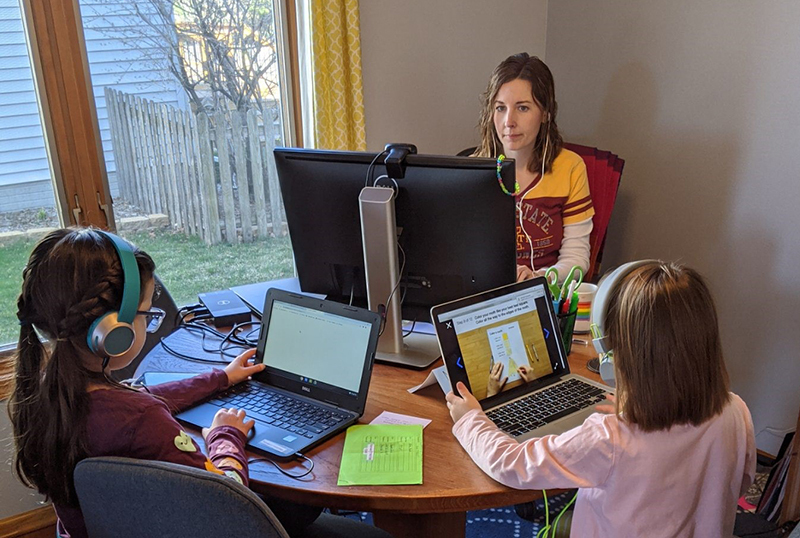
Liz Harris, advising coordinator for the human development and family studies department, shares the family's dining room table with her two elementary-age daughters. Submitted photo.
We asked you to share photos of your home offices -- and perhaps your new workmates. And the response was so generous we weren't able to include all the submissions. So, here's a gallery of some of the thousands of faculty and staff who carried out the ISU mission from an off-campus location for the last eight weeks.
With it, we send our gratitude to the university's essential employees, the front line staff who showed up and kept the physical campus humming to finish out a most unusual spring semester.
Gradual return to on-campus operations begins June 1
A limited number of faculty and staff will return to their usual workplaces June 1, a careful first step in the phased process of resuming Iowa State's on-campus operations.
President Wendy Wintersteen outlined broad strokes of the summer resumption in a May 8 message to faculty and staff. University human resources (UHR) will release guidance on the details in the coming days. Supervisors will contact employees as plans develop.
Returning employees will be expected to maintain social/physical distancing, including staying at least 6 feet from other people and avoiding gathering in groups or crowds. In some workspaces, that could require rotating schedules due to capacity issues.
Employees who want to continue working from home after June 1 should discuss options with their supervisors, who should be flexible with workers with child care challenges or high-risk health concerns. If a supervisor requires an employee to return to their usual workplace, they must provide a two-week notice.
Faculty and staff are urged to continue limiting face-to-face interaction when possible, connecting by phone calls and videoconferencing instead of in-person meetings. They also should monitor their health and stay home if sick or showing illness symptoms.
The forthcoming UHR guidance will include information about face coverings and facilities plans. Buildings shut down since limited operations began in mid-March will need some attention before they are occupied again. Most campus facilities will remain locked and accessible only by keycard after June 1.
Additional information about increasing research activity on campus will be shared May 18, following up on the April 23 guidance from the office of the vice president for research.
Implementation continues for new P&S structure
The first part of the process to implement the new classification and compensation system for the university's 3,200 professional and scientific (P&S) employees is complete: Leaders across campus, aided by their HR delivery teams as needed, have linked their employees to job titles in the new classification system. Central university human resources (UHR) staff now are in the process of reviewing those assignments, said Emma Mallarino Houghton, UHR classification and compensation director.
Implementation steps that remain, she said, are:
- UHR sends notification of their new job classification assignment to all P&S employees and their supervisors.
- Employees learn more about their job classification using tools provided by UHR, ask questions and, if desired in partnership with their manager, may request a review of their placement in the new structure. Reviews will be aided by HR delivery teams.
- Following that review period, the new P&S system, including the market-based pay grades, will go live in Workday.
Pandemic-related impacts across the university diverted staff time from implementing the new P&S structure during the last eight weeks, Mallarino Houghton said.
"We kept moving on our work, but with other priorities emerging, we're delayed in meeting the implementation milestones we shared with the campus community earlier this spring," she said.
Revised timeline to be determined
Prior to the COVID-19 pandemic, May 31 was the target to complete implementation. Mallarino Houghton said an updated implementation timeline, including the window for employee review, will be shared once it is known.
She said UHR staff are working to finalize information for the class/comp project website before the employee review process begins. As it becomes available, the content will help employees and their managers understand the new structure and includes:
- Level guides for each of the three categories of jobs: support contributor, individual contributor and management.
- Documents to help employees understand and interpret the level guides.
- Tips to help employees assess the accuracy of their new job title.
- Lists of the job families (29) and job titles (575+) in the new structure.
Evans named to dean of students post
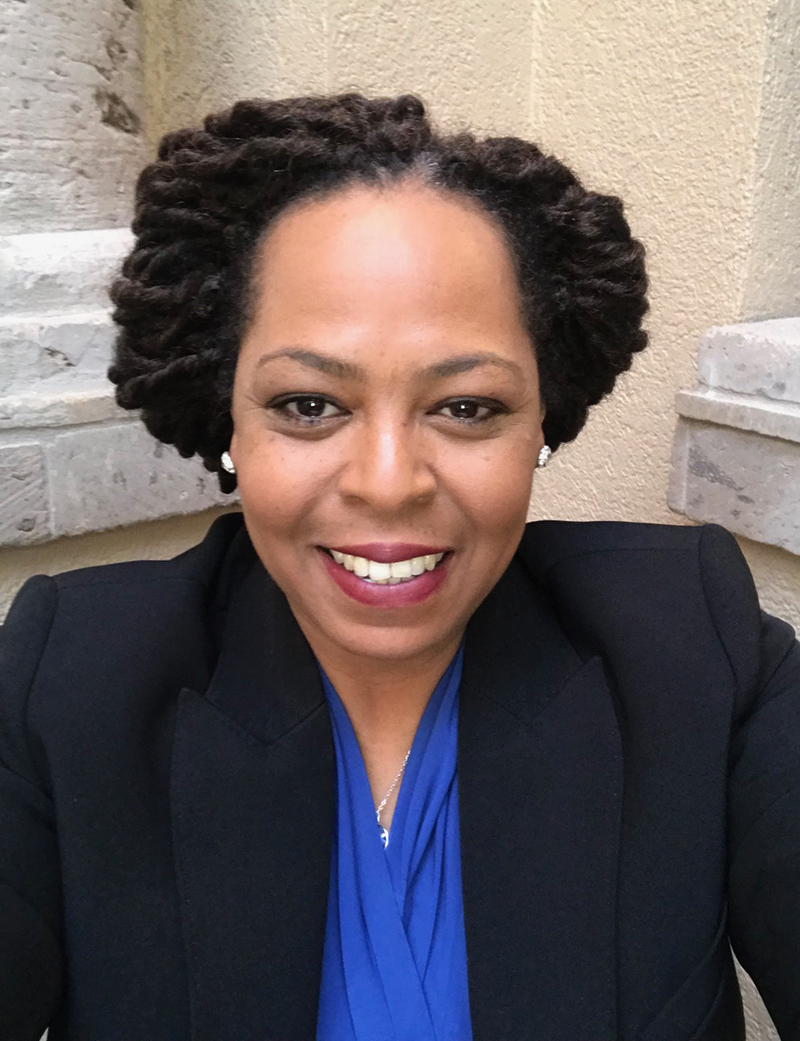
Sharron Evans
Sharron Evans, a private practice attorney and higher education consultant, has been named associate vice president in the student affairs division and dean of students, effective May 18. She has more than 20 years of experience in higher education student affairs, most recently (2018) as vice president for student affairs and dean of students at Roosevelt University, Chicago.
"Sharron has held key positions in higher education, giving her a wealth of experience. She exudes a commitment to supporting students and is excited about working at Iowa State University," said senior vice president for student affairs Martino Harmon. "Her education, experiences and ability to build relationships make her an outstanding choice to serve as our associate vice president and dean of students."
Evans has experience in student development, organizational management, diversity and inclusion, assessment, compliance and crisis intervention and management. At Roosevelt University, she supervised the dean of students office, counseling center, office of student rights and responsibilities, residence life, academic success center, multicultural student support services and the office of Title IX compliance. She provided counsel to the president on a variety of issues, including diversity and inclusion, student crises and student demonstrations, and managed the division through difficult financial times.
"First and foremost, I would like to say thank you to the search committee and all members of the ISU community who were able to participate in the search process," Evans said. "Not far into the search, it became apparent to me that Iowa State felt like home. It is an absolute honor to join the Cyclone community and to serve colleagues and students across the campus.
"I am so excited about becoming a part of the rich ISU legacy, which includes an exceptional student body, faculty, staff and division of student affairs," she said.
Evans will report to the senior vice president for student affairs. She will lead the following units under the dean of students umbrella:
- Academic Success Center
- Center for LGBTQIA+ Student Success
- Fraternity and sorority engagement
- Hixson opportunity awards
- International students and scholars
- Margaret Sloss Center for Women and Gender Equity
- Multicultural student affairs
- Student accessibility services
- Student assistance
- Student conduct
- Student legal services
- Student support services (TRIO)
- Veterans Center
- Writing and Media Center
Evans holds a bachelor's degree in criminal justice sciences (1993) and master's degree in education (1997) from Illinois State University, Normal; and a juris doctor (2013) from John Marshall Law School, University of Illinois at Chicago.
She succeeds Vernon Hurte, who left Iowa State in February to become vice president of student affairs at Towson University, Maryland. Harmon led the dean of students office in the interim.
Workday, ISD made shift to remote work easier
The hard work of launching Workday in 2019 is paying off in 2020, project leaders told the Professional and Scientific Council at its May 7 meeting.
The cloud-based enterprise software for managing Iowa State's financial and human resources transaction went live July 1, 2019, as did improved service delivery, a related project that created centralized service teams of human resources and finance specialists. The teams receive, address and track requests for assistance with another platform new to ISU in 2019, ServiceNow, an email-based ticketing system also used by information technology services. Numerous aging software programs and paper-based processes were eliminated in the shift.
Those changes have allowed effective remote work by HR and finance specialists during the coronavirus crisis, said Dwaine Heppler, associate vice president for HR services and strategy.
"If we were in this situation a year ago, without the tools we have in place, we would not have been nearly as successful in continuing to do the work our teams are doing," he said.
Interim vice president and chief information officer Kristen Constant said she's grateful for the timing of the project.
"We can't imagine how we would have handled these things even just last year, much less five years ago. As painful as the transition has been, we have already seen much of the payoff from that investment," she said.
Service team stats
Heppler and Heather Paris, associate vice president for finance and support services, gave the council an update on some key performance indicators for the service teams during the third quarter, January through March.
During those three months, finance service teams responded to 16,686 incidents, about 185 per day. The average request was resolved in 1.3 days. HR service teams saw 1,781 incidents, about 43 per day, which were resolved in 1.6 days, on average.
Employees seem to appreciate the level of service they're getting, based on responses to surveys offered after each ServiceNow ticket is closed. In the third quarter, 85% of respondents said they were satisfied or very satisfied with their interaction with a finance service team, 97% said it was helpful and 95% said their question was addressed. For HR requests, 84% were satisfied, 91% found the service helpful and 97% said their question was addressed.
Both service areas identified areas for improvement. Finance teams are working on simplifying financial reporting for faculty, especially on grants, Paris said. HR teams are looking at how to improve local support for student and graduate assistant hiring and oversight to take some burden off faculty and unit leaders, Heppler said.
Fall planning
Senior vice president and provost Jonathan Wickert and vice president for extension and outreach John Lawrence talked to the council about planning to welcome students back in the fall for in-person courses and the other learning opportunities a residential campus provides.
"It may be the biggest challenge the university has ever had," Wickert said.
Wickert said one of the highest priorities will be planning instruction in courses that will meet face-to-face, including labs and studios. All possible options are being explored, including physical distancing, cloth face coverings, enhanced cleaning, use of larger rooms and alternative schedules such as extending teaching hours into evenings and weekends.
Lawrence is chairing a committee leading the planning work, which is in its early stages. The committee meets daily. He encouraged employees to send suggestions and comments to Fall20plans@iastate.edu.
"Innovations are going to come from people who engage with students as their core mission," Lawrence said.
Council member Chris Myers, Biology 211 lab coordinator, asked about the best way to share specific ideas he has for mitigating risk in his course. Wickert recommended meeting with the college's associate dean, perhaps along with lab coordinators from other departments.
"We're going to do this together, and we need every good idea. You know best what that lab is like and what that lab needs," Wickert said.
Guess who's attending today

Systems support specialist Paul Easker has an elaborate work station at home. Submitted images.
So, you pride yourself on the spirited or clever virtual backgrounds you've discovered during this pandemic. Your web conferences are the better for them, no doubt. Systems support specialist Paul Easker takes it up a notch when he joins his colleagues in the Virtual Reality Applications Center (VRAC) for their weekly staff conferences. Among a group of technically capable professionals, that's no simple task. Easker shows up in a costume to match his background.
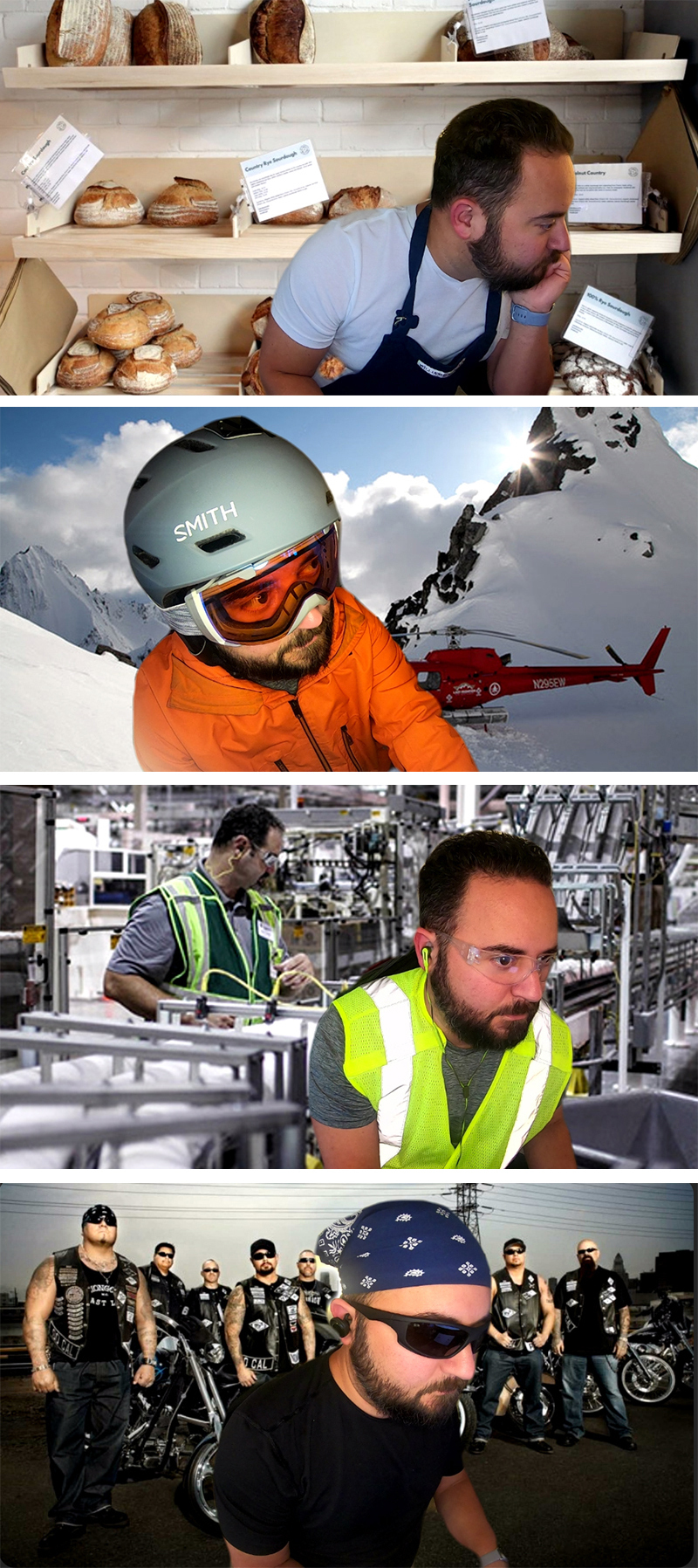
For example, back in late March, he decided he wanted to be part of the solution to a national shortage, so he placed himself on the manufacturing line in a toilet paper factory. The next week he pondered local needs and settled on making bread so people could eat. Paul the baker sat in on the next VRAC meeting.
The impetus, he said, really was the isolation he felt after a few days of working at home, with just one roommate to talk to for long stretches.
"It just seemed like it could be a good way to get people smiling and to spread some joy," he said.
Easker checks closets and dressers in his apartment for props and finds an appropriate image on the internet for his background.
He also showed up for meetings as a biker gang member, a beach lounger and a heli-skier about to depart on his descent -- though he confessed the ski gear was too warm to survive the entire staff meeting.
"It's been fun so far. A few staff have told me they look forward to the meetings to see what I am going to do next," he said.
Did you know?
Many Iowa State units have produced Zoom backgrounds employees are welcome to use.
Perennials installed in sculpture garden
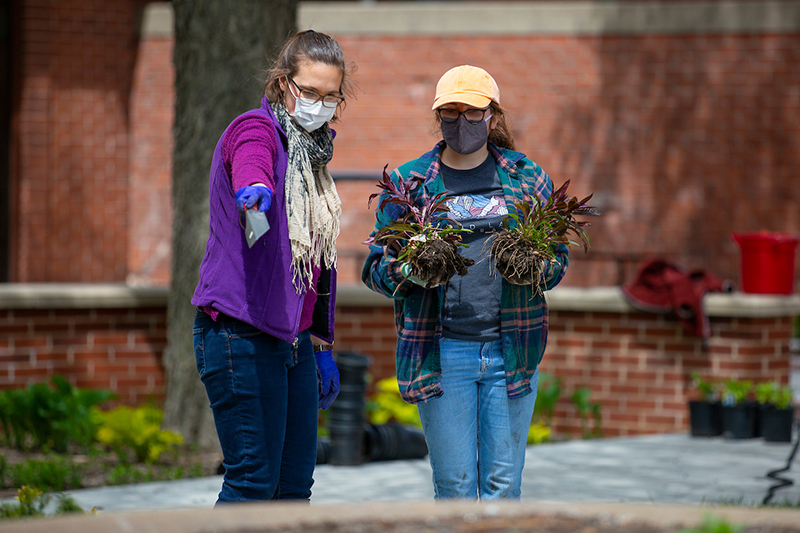
University museums' Lilah Anderson (left), educator of visual literacy, and student intern Ellen Sattler confer on the placement of perennials in the Anderson Sculpture Garden. Photos by Christopher Gannon.
University museums staff and student interns kicked off the summer this week by adding about 200 perennial plants to the Elizabeth and Byron Anderson Sculpture Garden surrounding Morrill Hall. Ellen Sattler, the museums' second-ever intern assigned specifically to the sculpture garden, selected plants and determined their locations during spring semester, supervised by Lilah Anderson, educator of visual literacy, who also has experience designing landscapes. They presented their plan to landscape architect Rhonda Martin in the campus services unit of facilities planning and management.
Following this week's installation, Sattler will spend part of her summer weeding, watering and pruning in the garden. This fall, she begins her senior year, majoring in horticulture and English.
She said she researched and selected plants for how they relate to each other and how they "talk" to the sculptures nearby. For example, in the area surrounding Christian Petersen's Panthers, she picked plants whose height, flowers and texture suggest a wild or rugged environment to complement the sculpture.
Sattler's internship and the plants are covered by funds from university museums donor Elizabeth Anderson, who helped establish the outdoor sculpture area in memory of her husband, Byron.
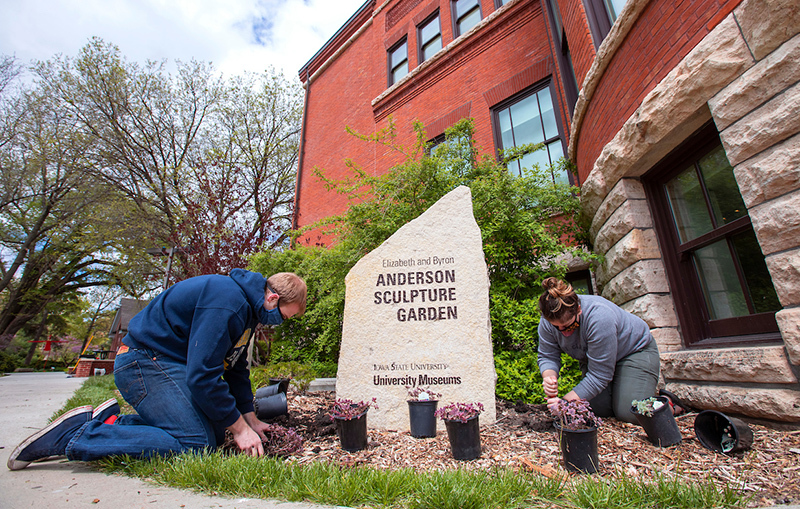
University museums intern Quinn Vandenberg (left) and interpretive specialist Brooke Rogers plant perennials Monday in the Anderson Sculpture Garden south of Morrill Hall.
